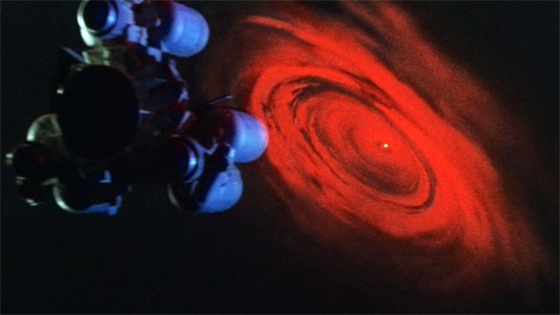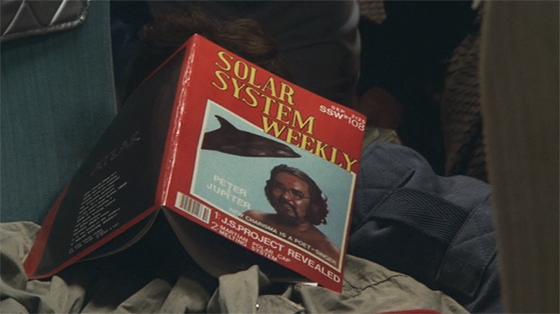
It is the year 2125. The Earth’s population is 18 billion, and colonies throughout the solar system hold an additional five billion (the opening titles inform us). New sources of energy and sustenance are urgently pursued to sustain those vast numbers. On Mars, the polar ice cap is detonated to melt free a new source of water; but it also reveals previously hidden markings on the planet’s surface, pictographs which suggest an ancient alien intelligence, a la Chariots of the Gods. A similar discovery is about to be made on Jupiter. An operation known as the J.S. (“Jupiter Solarization”) Project hopes to use a chain reaction of nuclear fusion to transform the planet into a sun, thus providing a source of energy for the outer colonies. But the planet hides a secret: something strange and mammoth hides deep within the gas giant, which transmits a mysterious signal when two officers, “Chief Investigator” Eiji Honda (Tomokazu Miura) and “intergalactic linguist” Millicent Willem (Rachel Huggett), fly their shuttle dangerously close to the alien object. Meanwhile, a black hole begins to materialize near the planet, swallowing one of their vessels and threatening to consume Earth within two years. A plan is hatched to “divert the path” of the black hole by slightly modifying the J.S. Project – the planet will be exploded instead. When word of the new plan reaches the protest group called the Jupiter Church – led by a grinning, guitar-toting, dolphin-owning hippie named Peter (Paul Tagawa) – they attempt sabotage with explosives and laser guns.
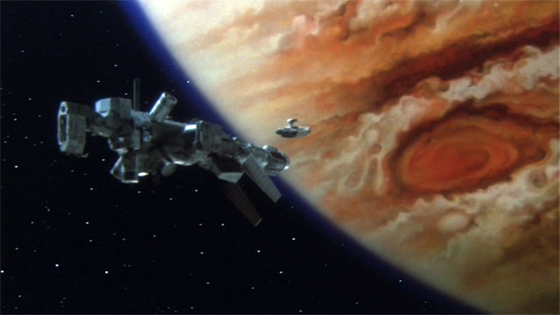
Koichi Kawakita, of the "Ultraman" series, provides the special effects for "Sayonara Jupiter."
The Toho Company hoped that Sayonara Jupiter (1984) would be a dazzling science fiction spectacle to rival those coming out of Hollywood. It was an ambitious production. The expensive special effects (by Koichi Kawakita) largely move beyond the “toy model” look of earlier Toho films; the “Jupiter Ghost,” an alien spaceship decorated with lights and lurking within violent storms near the planet’s nucleus, is particularly impressive-looking near the film’s climax. Director Koji Hashimoto, a Toho assistant director graduating to the big leagues, makes the unique decision to represent a genuinely international space colony on “Minerva Base” by casting American, French, British, and German actors alongside his Japanese stars, many speaking their native language. (Hashimoto would next helm Godzilla 1985, Toho’s attempted reboot of their most famous franchise; one of the officers in Sayonara Jupiter watches Ghidorah, the Three-Headed Monster, a 1964 Godzilla film.) Questions are asked in Japanese and answered in English, and vice versa, as though everyone on Minerva refuses to sync. This Tower of Babel approach proves to be a major miscalculation, one of the film’s many. The English-speaking actors are amateurs with no screen presence and community theater delivery. Because of this, unintentional laughs begin at about six minutes into the film, and don’t let up for the next two hours-plus.
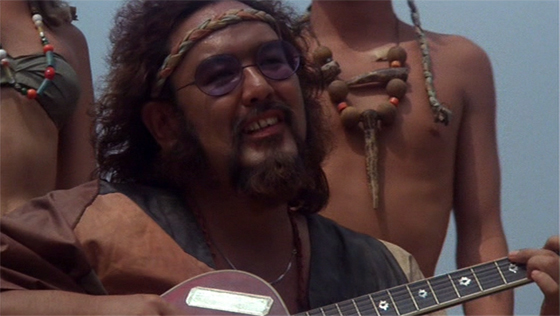
"Peter" (Paul Tagawa) leads the cult known as the Jupiter Church with pop songs and dolphin tricks.
I mean, where to begin? After acolytes of the Jupiter Church are arrested for a crazed protest at Minerva Base (they smash a single computer over and over), Honda recognizes one of them as the love of his life, Maria (Diane Dangely) – who’s French, to keep with the multinational theme – and immediately grabs her by the hand and runs with her in slow-motion through the halls of the ship. When they reach his private cabin, they make zero-gravity love, Moonraker-style. In an abstract sequence, they float naked through the cosmos, holding hands like Superman and Lois Lane, while delivering background exposition that amounts to: they haven’t seen each other for years; he likes outer space; she doesn’t really care for it. Within the blink of an eye, Maria is back on Earth along with the rest of her protest group, whose daily activities apparently consist of hanging out on a sunny beach, tanning, windsurfing, and smiling with glazed eyes at their leader and spiritual guide, the aforementioned Peter, who has a pet dolphin named Jupiter, and sings pop music about how wonderful the Earth is. The beach scenes suggest a J-pop video directed by Roger Corman. An underwater camera captures a woman swimming topless, her breasts gliding slowly toward the camera, as though this is going to be that kind of movie. Late in the film, a killer shark attacks poor Jupiter, gorily mauling him to death. Honda – on a rare visit to his home planet – attempts to recreate the climax of Jaws by throwing explosives into the water and firing at them with a pistol. When the shark cannily dodges the explosions, Honda plunges the boat’s propeller into its face and grinds it into pieces. Returning to the beached and blood-drenched dolphin, Honda looks at the bikini-clad girls and beach bums and asks optimistically, “Is there a vet around?”
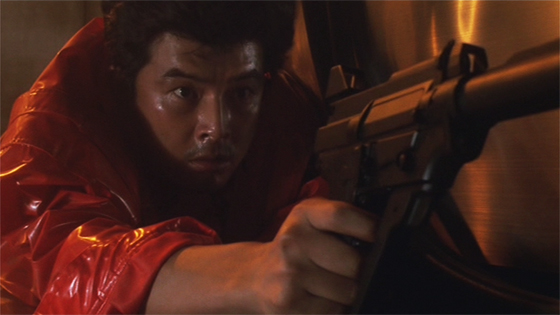
Honda (Tomokazu Miura) engages in a laser shootout with terrorists.
Shark attacks, zero-gravity sex, and J-pop videos aside, there are unmistakable plot similarities to Arthur C. Clarke’s 2010: Odyssey Two, which also involved alien intelligence near Jupiter and the conversion of the planet into a sun. Clarke’s 2001 sequel was written first as a 10-page film outline, then as a novel from 1981-1982; appropriating an idea from Stanley Kubrick’s film, he changed the story’s key planet from Saturn to Jupiter, since new Voyager flybys of Jupiter and its moons had opened up some narrative possibilities. The film of 2010, directed by Peter Hyams, arrived in theaters in December 1984. Sayonara Jupiter hit theaters first, though America remained largely ignorant of its existence, and it certainly had no impact on 2010‘s box office. Hashimoto’s film was written by Sakyo Komatsu, adapting his own two-volume novel published in 1982, the same year as Clarke’s book. I’m inclined to think that similarities between the two projects are therefore coincidental, though it’s not out of line to suggest that the Japanese film’s production was aware of the forthcoming Hyams film and positioning themselves as a friendly rival. This isn’t the cinematic equivalent of the space race: Sayonara Jupiter, in a gesture of polite diplomacy, dedicates itself to NASA. I’m not sure what NASA engineers would have thought of the film’s questionable physics and gonzo exploitation elements. After a few beers, they’d probably get a kick out of it.
